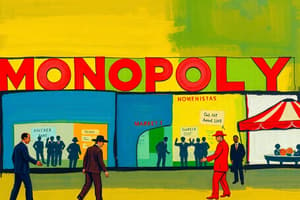Podcast
Questions and Answers
Which characteristic distinguishes a monopoly from other market structures?
Which characteristic distinguishes a monopoly from other market structures?
- Minimal advertising expenditure.
- A standardized product sold by many firms.
- A single seller with a unique product and significant barriers to entry. (correct)
- Numerous sellers offering differentiated products.
In a monopolistic market, what is the primary implication of a downward-sloping demand curve for the monopolist?
In a monopolistic market, what is the primary implication of a downward-sloping demand curve for the monopolist?
- The monopolist's revenue is unaffected by changes in quantity sold.
- The monopolist must lower the price to sell additional units. (correct)
- The monopolist can sell any quantity at a fixed market price.
- The monopolist faces a perfectly elastic demand for its product.
What is the most direct impact of strong economies of scale on potential new entrants in a monopolistic industry?
What is the most direct impact of strong economies of scale on potential new entrants in a monopolistic industry?
- New firms can quickly achieve cost parity with the established monopolist.
- New firms find it easier to compete due to lower initial investment costs.
- New firms are encouraged to enter the market, increasing competition.
- New firms face significant cost disadvantages competing with the existing large-scale producer. (correct)
How does a patent primarily contribute to maintaining a firm's monopoly power?
How does a patent primarily contribute to maintaining a firm's monopoly power?
What is the role of licenses in creating and sustaining a monopolistic market structure?
What is the role of licenses in creating and sustaining a monopolistic market structure?
How might a monopolist's control over essential raw materials impact potential competitors?
How might a monopolist's control over essential raw materials impact potential competitors?
What is the relationship between demand elasticity and a monopolist's pricing decisions?
What is the relationship between demand elasticity and a monopolist's pricing decisions?
Which of the following scenarios best illustrates a barrier to entry that sustains a monopoly?
Which of the following scenarios best illustrates a barrier to entry that sustains a monopoly?
Flashcards
Monopoly
Monopoly
A market structure with a single seller dominating the market.
Single Seller
Single Seller
Many buyers but only one seller.
Unique Product
Unique Product
A product with no close alternatives available to consumers.
Price Maker
Price Maker
Signup and view all the flashcards
Barriers to Entry
Barriers to Entry
Signup and view all the flashcards
Economies of Scale
Economies of Scale
Signup and view all the flashcards
Control of Resources
Control of Resources
Signup and view all the flashcards
Licenses
Licenses
Signup and view all the flashcards
Study Notes
Characteristics of a Monopoly
- Single seller exists with a large number of buyers.
- The product is unique with no close substitutes.
- The monopoly is a price maker.
- Significant barriers to entry exist.
- Minimum advertising is typically needed
Barriers to Entry
- Barriers to entry prevent other firms from entering the industry.
- Weaker barriers to entry may permit entry of a few firms, leading to an oligopoly.
Types of Barriers to Entry
- Occurs when the average cost decreases as output production expands.
- In a monopoly, new firms cannot enter due to economies of scale.
- Protected from competition.
- New firms must start large-scale operations to enter, which is difficult.
- Small-scale producers struggle to achieve normal profits and usually fail.
Ownership / Control
- Monopolists may prevent rivals by controlling raw materials.
- For example, a sugar producer in Malaysia controls the resources, making new entry nearly impossible.
Licenses
- The government may restrict new firms by requiring a legal license.
- The imposition of licenses on television stations can prevent potential firms from entering, encouraging a monopoly.
Patents and Copyright
- A patent gives the inventor the exclusive right to use or allow its use.
- Patent laws prevent competitors, providing monopoly power for the patent's life.
- Copyrights prevent rivals from copying products, making entry impossible.
- A copyright gives exclusive rights to authors, music composers, film producers, etc.
Monopoly Demand Curve
- The key difference between a competitive firm and a monopolist is on the demand side.
- Demand curve for a monopoly firm slopes downward, following the law of demand.
- The monopolist sets the price based on demand elasticity and total revenue.
Marginal Revenue
- The marginal revenue curve lies below the demand curve.
- When MR is positive (or MR<0), demand is inelastic, increasing total revenue as prices rise.
- Total revenue is unchanged with price changes when demand is unitary elastic, and MR = 0.
Monopoly Short Run Equilibrium (Profit Maximisation)
- Total approach to profit maximisation conditions using total revenue and total cost is applicable in a monopoly market.
- The vertical distance between total revenue and total cost shows the total profit.
- The difference between TR and TC is highest when the quantity is at 3 units.
- This results in a maximum profit of USD160 and represents the firm's equilibrium.
- Marginal revenue curve lies below the demand curve.
- Monopoly achieves equilibrium when marginal revenue equals marginal cost.
- The intersection between MR and MC shows on the graph at point E*.
- Profit-maximising price shows on the graph at P*.
Short Run Profit Types
- A monopolist earns supernormal profit when average revenue is greater than average cost, due to graphs.
- Equilibrium is at the point where Marginal Revenue equals Marginal Cost.
- The profit maximizing quantity is at Q and the monopolist changes the price at A shown on the graph.
- The shaded area ACDB represents supernormal profit.
- A monopolist may experience losses when average revenue is less than average cost at equilibrium of position MR = MC (point E*) on graphs.
- Profit maximisation is obtained at Q, with price at B, visually using graphs.
- The monopolist faces these losses visually represented by the shaded area ADCB.
- If at the equilibrium point, MR = MC the monopolist will have a break even/profit and a normal profit on graphs.
- AR equals AC, hence the monopolist earns normal profit.
Monopoly Long Run Equilibrium
- Long-run equilibrium follows the short-run equilibrium (MR = MC).
- A monopolist earns supernormal profit due to barriers to entry.
- With no competition, the monopolist adjusts prices based on costs.
- They may increase prices to avoid losses if production costs increase.
Long run Model
- Long-run equilibrium achieved when LRMR = LRMC at point E*
- Profit-maximising price is at point A, output at point Q
- ACBD the shaded area, represents supernormal profit because it is gained due to barriers to entry.
Studying That Suits You
Use AI to generate personalized quizzes and flashcards to suit your learning preferences.




